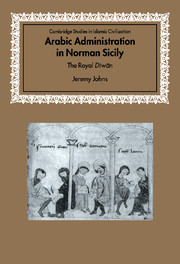Book contents
- Frontmatter
- Contents
- Preface
- Tables
- Abbreviations
- Genealogical table of the De Hautevilles of Sicily
- Note on Measurements
- Introduction
- 1 ‘In the time of the Saracens …’
- 2 ‘When first the Normans crossed into Sicily …’
- 3 ‘Our lady, the Regent Adelaide, and our Lord, the Count Roger, her son’, 1101–30
- 4 The earliest products of the royal dīwān, 1130–43
- 5 The jarāʾid renewed, 1144–5
- 6 The records of the royal dīwān. Part I: the jarāʾid al-rijāl
- 7 The records of the royal dīwān. Part II: the dafātir al-ḥudūd
- 8 The duties and organisation of the royal dīwān, 1141–94
- 9 ‘The people of his state’. The ‘palace Saracens’ and the royal dīwān
- 10 The Norman dīwān and Fāṭimid Egypt
- 11 Royal dīwān and royal image
- Appendix 1 Catalogue of dīwānī documents
- Appendix 2 Provisional catalogue of private documents
- Appendix 3 Abū Tillīs – ‘Old Wheat-sack’
- List of References
- Index
- Titles in the series
6 - The records of the royal dīwān. Part I: the jarāʾid al-rijāl
Published online by Cambridge University Press: 10 March 2010
- Frontmatter
- Contents
- Preface
- Tables
- Abbreviations
- Genealogical table of the De Hautevilles of Sicily
- Note on Measurements
- Introduction
- 1 ‘In the time of the Saracens …’
- 2 ‘When first the Normans crossed into Sicily …’
- 3 ‘Our lady, the Regent Adelaide, and our Lord, the Count Roger, her son’, 1101–30
- 4 The earliest products of the royal dīwān, 1130–43
- 5 The jarāʾid renewed, 1144–5
- 6 The records of the royal dīwān. Part I: the jarāʾid al-rijāl
- 7 The records of the royal dīwān. Part II: the dafātir al-ḥudūd
- 8 The duties and organisation of the royal dīwān, 1141–94
- 9 ‘The people of his state’. The ‘palace Saracens’ and the royal dīwān
- 10 The Norman dīwān and Fāṭimid Egypt
- 11 Royal dīwān and royal image
- Appendix 1 Catalogue of dīwānī documents
- Appendix 2 Provisional catalogue of private documents
- Appendix 3 Abū Tillīs – ‘Old Wheat-sack’
- List of References
- Index
- Titles in the series
Summary
The jarāʾid al-rijāl
None of the records used by the royal dīwān for the administration of Sicily have survived, and their very existence has to be inferred almost entirely from the few documents issued by the dīwān which are preserved in their original form. Most records, such as the accounts of income and expenditure, the registers of service owed by the barons and knights of the island, or the formularies used by scribes for composing documents, have disappeared practically without trace. Others, such as the dafātir al-īṣāl al-dīwānīya, the ‘dīwāni registers of receipt’, are named but once (Dīwānī 35). For only two sets of records does sufficient information survive to justify an attempt to reconstruct their coverage, format, and purpose. This chapter discusses the jarāʾid al-rijāl, or the registers of villeins on the royal demesne; the next is dedicated to the dafātir al-ḥudūd, or the registers of land boundaries.
During the repartition of the lands and inhabitants of Sicily which took place immediately after the conquest was complete, the preferred method of redistribution was to grant the inhabitants with the lands to which they were bound, and to register their names in a plateia or jarīda – it was simpler and quicker to name the villeins than to describe their property. A large, but unknown, number of plateiai were compiled for Count Roger and for his barons at Mazara in 1093 (Dīwānī 1). The stipulatory clauses, or shurūṭ, of the jarāʾid renewed in 1145 make repeated reference to ‘the jarāʾid of the dīwān al-mafimūr’, and imply that they were the descendants of ‘the jarāʾid which were written at Mazara’.
- Type
- Chapter
- Information
- Arabic Administration in Norman SicilyThe Royal Diwan, pp. 144 - 169Publisher: Cambridge University PressPrint publication year: 2002

